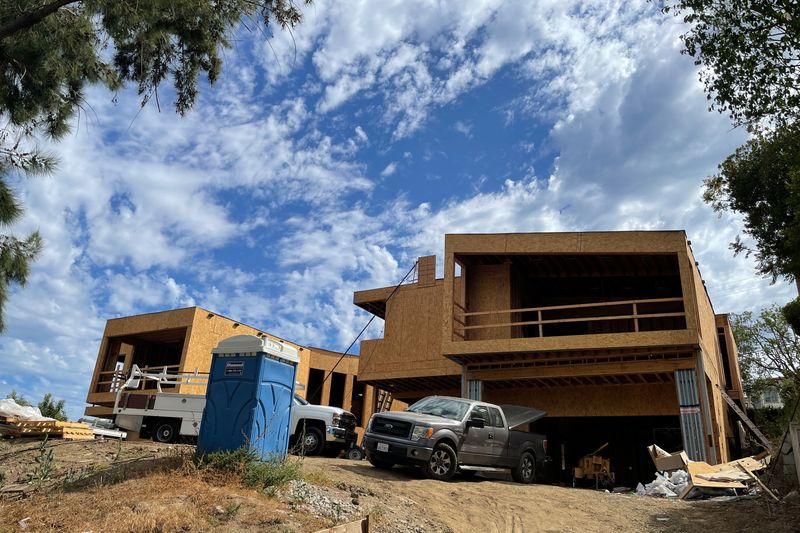By Lucia Mutikani
WASHINGTON (Reuters) - U.S. homebuilding fell to the lowest level in nearly 1-1/2 years in July, weighed down by higher mortgage rates and prices for construction materials, suggesting the housing market could contract further in the third quarter.
The housing market's declining fortunes brought fears of a broader economic recession back into focus. But with other data on Tuesday showing industrial production rising to an all-time high last month despite the high interest rate environment, the Federal Reserve is expected to stay on its aggressive monetary policy tightening path.
"Reading the tea leaves on the economy hasn't been this difficult in years," said Christopher Rupkey, chief economist at FWDBONDS in New York. "Industrial production has turned down in every economic recession in history, so the record high this month is not consistent with a downturn."
Housing starts plunged 9.6% to a seasonally adjusted annual rate of 1.446 million units last month, the lowest level since February 2021. Data for June was revised slightly higher to a rate of 1.599 million units from the previously reported 1.559 million units. Economists polled by Reuters had forecast starts would decline to a rate of 1.540 million units.
Graphic: Housing starts dropped sharply in July https://graphics.reuters.com/USA-ECONOMY/HOUSING/klvykymnwvg/chart.png
Single-family housing starts, which account for the biggest share of homebuilding, dropped 10.1% to a rate of 916,000 units, the lowest level since June 2020. Single-family homebuilding decreased in the Midwest and the densely populated South, but rose in the West and Northeast.
Starts for housing projects with five units or more declined 10.0% to a rate 514,000 units. Multi-family housing construction remains supported by strong demand for rental apartments, with rising borrowing costs pushing homeownership out of the reach of many Americans.
Permits for future homebuilding fell 1.3% to a rate of 1.674 million units. Single-family building permits dropped 4.3% to a rate of 928,000 units. Permits for multi-family housing projects increased 2.5% to a rate of 693,000 units.
The Fed, which is struggling to bring inflation back to the U.S. central bank's 2% target, has hiked its policy rate by 225 basis points since March. Mortgage rates, which move in tandem with U.S. Treasury yields, have soared even higher.
The 30-year fixed-rate mortgage is hovering around an average of 5.22%, up from 3.22% at the start of the year, according to data from mortgage finance agency Freddie Mac (OTC:FMCC).
Residential fixed investment declined at its steepest pace in two years in the second quarter, contributing to the second straight quarterly drop in gross domestic product during that period. More pain is likely yet to come for the housing market.
A survey on Monday showed the National Association of Home Builders/Wells Fargo Housing Market sentiment index fell for an eighth straight month in August, dropping below the break-even level of 50 for the first time since May 2020. Rising construction costs and mortgage rates were largely blamed for the drop.
Stocks on Wall Street were trading mixed. The dollar was steady against a basket of currencies. U.S. Treasury prices fell.
BROAD MANUFACTURING GAINS
While housing is struggling, another sector that is sensitive to interest rates is forging ahead for now.
In a separate report on Tuesday, the Fed said manufacturing output rebounded 0.7% in July after declining 0.4% in June.
Economists had forecast factory production would rise 0.2%. Output increased 3.2% compared to July 2021. Manufacturing, which accounts for 11.9% of the U.S. economy, remains supported by strong demand for goods even as spending is gradually shifting back to services.
But risks are rising, with retailers sitting on excess inventory, especially of apparel. A strong dollar as a result of tighter monetary policy could make U.S. exports more expensive.
Production at auto plants surged 6.6% last month. Excluding motor vehicles, manufacturing rose 0.3%. Output of long-lasting manufactured consumer goods increased 3.5%, while that of nondurable consumer goods fell 0.3%.
Mining production increased 0.7%, continuing to be underpinned by oil and gas extraction. Output at utilities fell 0.8%. The rise in manufacturing and mining output helped to lift the overall industrial production index by 0.6% to a record high of 104.8. Industrial output was unchanged in June.
Graphic: Industrial production https://graphics.reuters.com/USA-STOCKS/lbvgnazympq/indprod.png
The strong manufacturing production is in stark contrast with regional factory surveys that have shown a sharp deterioration in business sentiment.
"Recessions are normally a loss of faith, and it would appear that manufacturers' sentiment is frayed," said Ryan Sweet, a senior economist at Moody's (NYSE:MCO) Analytics in West Chester, Pennsylvania. "However, it's important to watch what manufacturers do rather than say. For now, manufacturers are not acting as if the economy is in or headed toward a recession."
Though higher borrowing costs are chilling the housing market, an outright collapse is unlikely because of a critical shortage of single-family homes for sale, which is keeping prices elevated. Fewer homes being built because of financial constraints could pose a conundrum for the Fed, which is seeking to bring down house prices by slowing demand for houses.
"Lower construction will limit the supply of housing and potentially dampen the impact of higher rates on home prices," said Isfar Munir, an economist at Citigroup (NYSE:C) in New York.

The number of houses approved for construction that are yet to be started surged 5.0% to 296,000 units. The single-family housing backlog increased 2.1% to 146,000 units, with the completions rate for this segment falling 0.8%.
The inventory of single-family housing under construction fell 1.2% to a rate of 816,000 units.
